Adam Tsakalidis
TempoFormer: A Transformer for Temporally-aware Representations in Change Detection
Aug 28, 2024



Abstract:Dynamic representation learning plays a pivotal role in understanding the evolution of linguistic content over time. On this front both context and time dynamics as well as their interplay are of prime importance. Current approaches model context via pre-trained representations, which are typically temporally agnostic. Previous work on modeling context and temporal dynamics has used recurrent methods, which are slow and prone to overfitting. Here we introduce TempoFormer, the fist task-agnostic transformer-based and temporally-aware model for dynamic representation learning. Our approach is jointly trained on inter and intra context dynamics and introduces a novel temporal variation of rotary positional embeddings. The architecture is flexible and can be used as the temporal representation foundation of other models or applied to different transformer-based architectures. We show new SOTA performance on three different real-time change detection tasks.
Clinically meaningful timeline summarisation in social media for mental health monitoring
Jan 29, 2024Abstract:We introduce the new task of clinically meaningful summarisation of social media user timelines, appropriate for mental health monitoring. We develop a novel approach for unsupervised abstractive summarisation that produces a two-layer summary consisting of both high-level information, covering aspects useful to clinical experts, as well as accompanying time sensitive evidence from a user's social media timeline. A key methodological novelty comes from the timeline summarisation component based on a version of hierarchical variational autoencoder (VAE) adapted to represent long texts and guided by LLM-annotated key phrases. The resulting timeline summary is input into a LLM (LLaMA-2) to produce the final summary containing both the high level information, obtained through instruction prompting, as well as corresponding evidence from the user's timeline. We assess the summaries generated by our novel architecture via automatic evaluation against expert written summaries and via human evaluation with clinical experts, showing that timeline summarisation by TH-VAE results in logically coherent summaries rich in clinical utility and superior to LLM-only approaches in capturing changes over time.
Sig-Networks Toolkit: Signature Networks for Longitudinal Language Modelling
Dec 06, 2023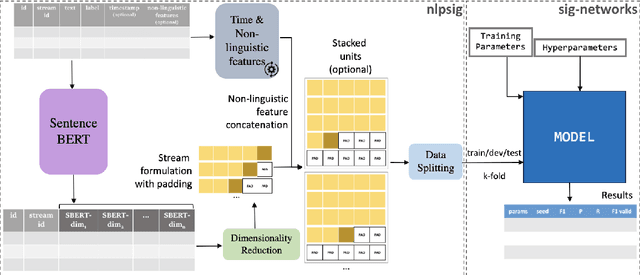
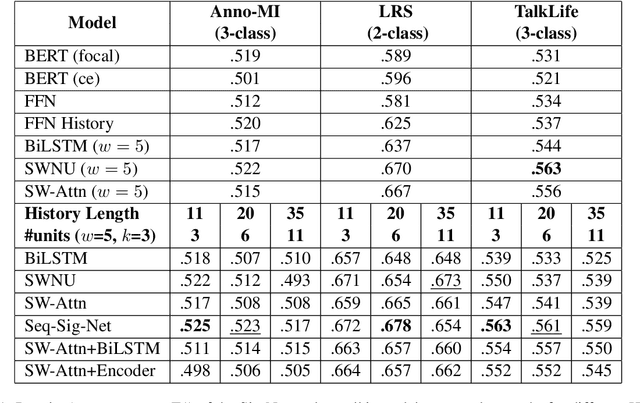
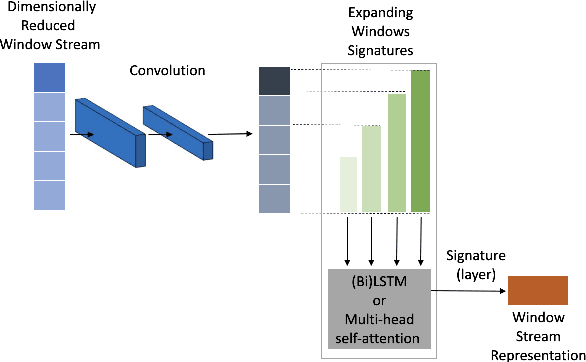
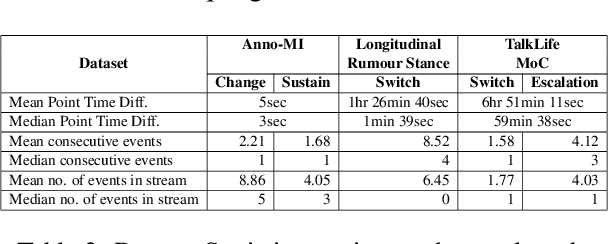
Abstract:We present an open-source, pip installable toolkit, Sig-Networks, the first of its kind for longitudinal language modelling. A central focus is the incorporation of Signature-based Neural Network models, which have recently shown success in temporal tasks. We apply and extend published research providing a full suite of signature-based models. Their components can be used as PyTorch building blocks in future architectures. Sig-Networks enables task-agnostic dataset plug-in, seamless pre-processing for sequential data, parameter flexibility, automated tuning across a range of models. We examine signature networks under three different NLP tasks of varying temporal granularity: counselling conversations, rumour stance switch and mood changes in social media threads, showing SOTA performance in all three, and provide guidance for future tasks. We release the Toolkit as a PyTorch package with an introductory video, Git repositories for preprocessing and modelling including sample notebooks on the modeled NLP tasks.
A Digital Language Coherence Marker for Monitoring Dementia
Oct 14, 2023Abstract:The use of spontaneous language to derive appropriate digital markers has become an emergent, promising and non-intrusive method to diagnose and monitor dementia. Here we propose methods to capture language coherence as a cost-effective, human-interpretable digital marker for monitoring cognitive changes in people with dementia. We introduce a novel task to learn the temporal logical consistency of utterances in short transcribed narratives and investigate a range of neural approaches. We compare such language coherence patterns between people with dementia and healthy controls and conduct a longitudinal evaluation against three clinical bio-markers to investigate the reliability of our proposed digital coherence marker. The coherence marker shows a significant difference between people with mild cognitive impairment, those with Alzheimer's Disease and healthy controls. Moreover our analysis shows high association between the coherence marker and the clinical bio-markers as well as generalisability potential to other related conditions.
Creation and evaluation of timelines for longitudinal user posts
Mar 10, 2023Abstract:There is increasing interest to work with user generated content in social media, especially textual posts over time. Currently there is no consistent way of segmenting user posts into timelines in a meaningful way that improves the quality and cost of manual annotation. Here we propose a set of methods for segmenting longitudinal user posts into timelines likely to contain interesting moments of change in a user's behaviour, based on their online posting activity. We also propose a novel framework for evaluating timelines and show its applicability in the context of two different social media datasets. Finally, we present a discussion of the linguistic content of highly ranked timelines.
Unsupervised Opinion Summarisation in the Wasserstein Space
Nov 27, 2022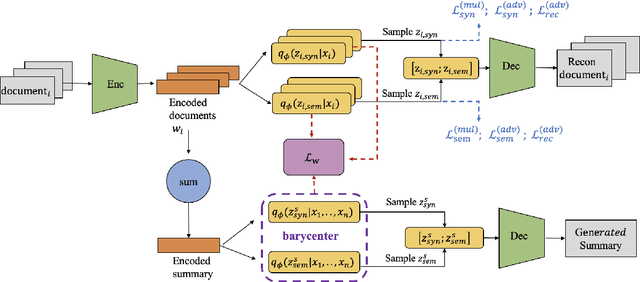
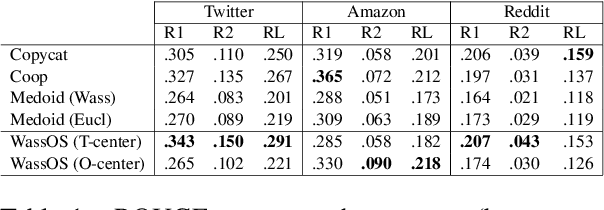
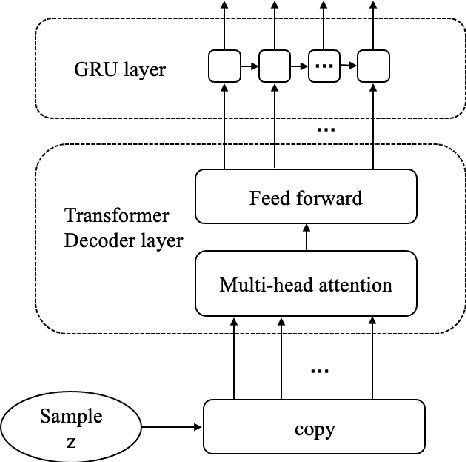

Abstract:Opinion summarisation synthesises opinions expressed in a group of documents discussing the same topic to produce a single summary. Recent work has looked at opinion summarisation of clusters of social media posts. Such posts are noisy and have unpredictable structure, posing additional challenges for the construction of the summary distribution and the preservation of meaning compared to online reviews, which has been so far the focus of opinion summarisation. To address these challenges we present \textit{WassOS}, an unsupervised abstractive summarization model which makes use of the Wasserstein distance. A Variational Autoencoder is used to get the distribution of documents/posts, and the distributions are disentangled into separate semantic and syntactic spaces. The summary distribution is obtained using the Wasserstein barycenter of the semantic and syntactic distributions. A latent variable sampled from the summary distribution is fed into a GRU decoder with a transformer layer to produce the final summary. Our experiments on multiple datasets including Twitter clusters, Reddit threads, and reviews show that WassOS almost always outperforms the state-of-the-art on ROUGE metrics and consistently produces the best summaries with respect to meaning preservation according to human evaluations.
Template-based Abstractive Microblog Opinion Summarisation
Aug 08, 2022



Abstract:We introduce the task of microblog opinion summarisation (MOS) and share a dataset of 3100 gold-standard opinion summaries to facilitate research in this domain. The dataset contains summaries of tweets spanning a 2-year period and covers more topics than any other public Twitter summarisation dataset. Summaries are abstractive in nature and have been created by journalists skilled in summarising news articles following a template separating factual information (main story) from author opinions. Our method differs from previous work on generating gold-standard summaries from social media, which usually involves selecting representative posts and thus favours extractive summarisation models. To showcase the dataset's utility and challenges, we benchmark a range of abstractive and extractive state-of-the-art summarisation models and achieve good performance, with the former outperforming the latter. We also show that fine-tuning is necessary to improve performance and investigate the benefits of using different sample sizes.
Identifying Moments of Change from Longitudinal User Text
May 11, 2022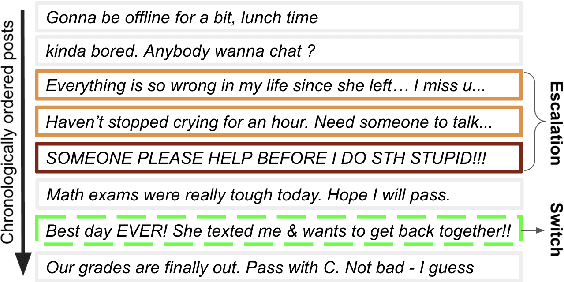

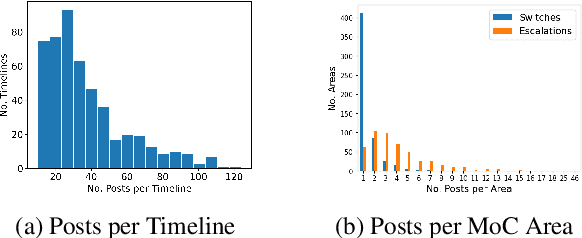

Abstract:Identifying changes in individuals' behaviour and mood, as observed via content shared on online platforms, is increasingly gaining importance. Most research to-date on this topic focuses on either: (a) identifying individuals at risk or with a certain mental health condition given a batch of posts or (b) providing equivalent labels at the post level. A disadvantage of such work is the lack of a strong temporal component and the inability to make longitudinal assessments following an individual's trajectory and allowing timely interventions. Here we define a new task, that of identifying moments of change in individuals on the basis of their shared content online. The changes we consider are sudden shifts in mood (switches) or gradual mood progression (escalations). We have created detailed guidelines for capturing moments of change and a corpus of 500 manually annotated user timelines (18.7K posts). We have developed a variety of baseline models drawing inspiration from related tasks and show that the best performance is obtained through context aware sequential modelling. We also introduce new metrics for capturing rare events in temporal windows.
A Longitudinal Multi-modal Dataset for Dementia Monitoring and Diagnosis
Sep 03, 2021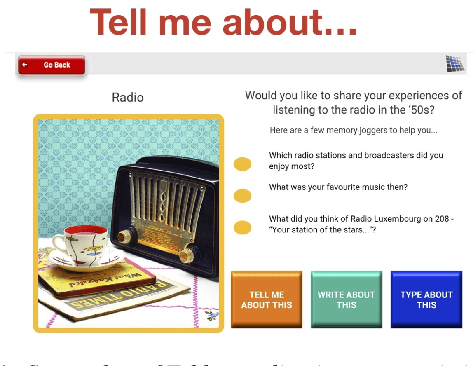

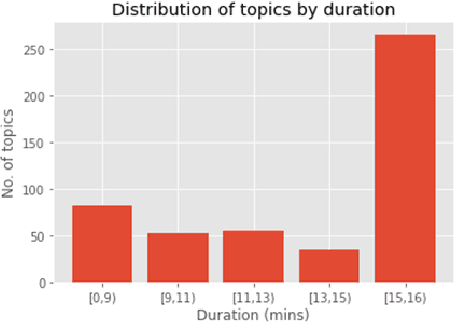

Abstract:Dementia is a family of neurogenerative conditions affecting memory and cognition in an increasing number of individuals in our globally aging population. Automated analysis of language, speech and paralinguistic indicators have been gaining popularity as potential indicators of cognitive decline. Here we propose a novel longitudinal multi-modal dataset collected from people with mild dementia and age matched controls over a period of several months in a natural setting. The multi-modal data consists of spoken conversations, a subset of which are transcribed, as well as typed and written thoughts and associated extra-linguistic information such as pen strokes and keystrokes. We describe the dataset in detail and proceed to focus on a task using the speech modality. The latter involves distinguishing controls from people with dementia by exploiting the longitudinal nature of the data. Our experiments showed significant differences in how the speech varied from session to session in the control and dementia groups.
DUKweb: Diachronic word representations from the UK Web Archive corpus
Jul 02, 2021



Abstract:Lexical semantic change (detecting shifts in the meaning and usage of words) is an important task for social and cultural studies as well as for Natural Language Processing applications. Diachronic word embeddings (time-sensitive vector representations of words that preserve their meaning) have become the standard resource for this task. However, given the significant computational resources needed for their generation, very few resources exist that make diachronic word embeddings available to the scientific community. In this paper we present DUKweb, a set of large-scale resources designed for the diachronic analysis of contemporary English. DUKweb was created from the JISC UK Web Domain Dataset (1996-2013), a very large archive which collects resources from the Internet Archive that were hosted on domains ending in `.uk'. DUKweb consists of a series word co-occurrence matrices and two types of word embeddings for each year in the JISC UK Web Domain dataset. We show the reuse potential of DUKweb and its quality standards via a case study on word meaning change detection.
 Add to Chrome
Add to Chrome Add to Firefox
Add to Firefox Add to Edge
Add to Edge